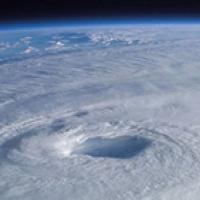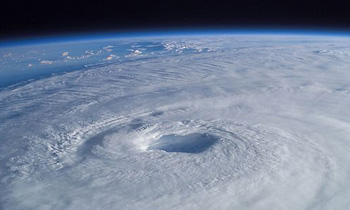
Why turbulence is troubling
Turbulence is something we are all familiar with. We've been on bumpy plane rides, admired raging rivers, or watched the water swirl away in our sink while brushing our teeth. But although we all know turbulence, nobody properly understands it. To scientists, mathematicians and engineers it presents a huge challenge — which is why the Isaac Newton Institute for Mathematical Sciences in Cambridge (INI) is currently hosting a major research programme on the topic.

This is Hurricane Isabel, which devastated parts of the US in 2003, as seen from the International Space Station. The clouds show a turbulent pattern on a large scale.
The tricky, and also amazing, thing about turbulence is that it occurs over a vast range of scales. "In the atmosphere you are talking about scales of thousands of kilometres, in the oceans maybe about hundreds of kilometres, and in your bathtub you are talking about centimetres," says John Gibbon who co-organises the INI programme. "There are also [turbulent flows on the scale of millimetres], and on the other end [of the spectrum], on astrophysical scales, you are talking about hundreds of millions of kilometres. So turbulence is a phenomenon that occurs everywhere."
Applications of an understanding of turbulence are equally wide-ranging. "Most flows in nature, whether it's at the astrophysical scale, the geophysical scale, or the laboratory scale, are turbulent," says Rahul Pandit, another organiser of the INI programme. We need to understand turbulence to come to grips with the Earth's climate and weather, and to understand planetary systems more generally. Bacteria in liquids can display behaviour that looks like turbulence, and turbulence is important in how pollutants and viruses mix with the liquids or gases they find themselves in. Engineering applications are near endless and there are huge economical and environmental implications. An important example is reducing the drag around an aircraft's wing: only a 1% saving in this drag can lead to a huge saving in fuel around the world.
What unites all these disparate strands is mathematics. There are two sets of equations that describe the motion of fluids. One is named after the 18th century mathematician Leonhard Euler and applies to fluids that aren't sticky, or viscous to give it the technical term. The other is named after the 19th century mathematicians Claude-Louis Navier and Gabriel Stokes, and does also apply to viscous fluids, such as honey or oil. The two sets of equations are closely related — you can read about the Euler equations here and the Navier-Stokes equations here.
"The thing that's fascinating about the Navier-Stokes equations, and makes [them] quite unique, is that there is almost no other physics equation that is valid over such a large range of scales," says co-organiser Jean-Luc Thiffeault. "You can use [them] for bacteria and you can use [them] for stars and inter-galactic media. The range of scales is unmatched."
Searching solutions
Given a particular fluid flow, be it oil flowing down a pipe or air around an aircraft wing, a solution to either the Euler or Navier-Stokes equations (whichever is relevant) would tell you the velocity and the pressure of the fluid at any point in time and space (given the properties the particular flow, which are encoded in parameters of the equations and boundary conditions). If we had nice formulae for the solutions, as we do for the kind of equations we meet at school, then we'd have complete control of all fluid flows: we could predict how they'll behave for all time and everywhere.

Turbulence also occurs in the oceans, at a smaller scale than it does in the atmosphere.
The trouble is that, for all but the simplest fluid flows, we don't have exact solutions. Instead, for most real-life situations, vast computing power is required to find accurate approximate solutions using something called computational fluid dynamics. And even that's not always possible. "We have a thing in our [field] called the Reynolds number, which represents the velocity of a fluid with respect to how sticky it is," explains Gibbon. "Modern computers can just about resolve flows with Reynolds numbers of up to 10,000 — those are the biggest [supercomputers] in the United States and Japan. But there are many flows in the atmosphere, and other places, where the Reynolds number takes values of millions. So we are nowhere near able to compute many representations of turbulent flows."
It's not just that solutions to the equations are hard to find — no one knows if they even exist for the most general form of the Navier-Stokes equations. And if they do exist, we still don't know if they involve oddities, such as discontinuities or infinities, that don't square with our intuition of how fluids should behave. The answer to this question can win you a million dollars from the Clay Mathematics Institute (find out more in this article).
"The thing that's really surprised everyone is how persistent [questions regarding solutions of the Navier-Stokes equations] turned out to be," says Thiffeault. "You'd think with such foundational [equations] in physics, you'd just be able to prove what you need to prove over a long weekend and then go home. It's the resistance of [these equations] — the longer [they] resist the more tantalising they become." The Euler equations, despite being a little older and in some sense simpler, have proved similarly stubborn.
Finding solutions
Decades of resistance don't however mean that nothing has happened. An example of the kind of puzzling development that can occur in this field happened only a couple of years ago, when mathematicians found so-called wild solutions of the Euler equations. These are mathematical solutions and it's not clear if they describe things that can happen in real life. If they do, then these things are very strange indeed.
"Say you put a glass of water on your bedside table and go to sleep," explains Gibbon. "Then while you are sleeping the water suddenly starts to go into motion and shakes, and then after a finite time it just stops. You wake up in the morning and [the glass] is just sitting there, smiling at you. The wild solutions behave in that way — we don't know what they mean, we don't even know if they are physical. They could be the precursors of turbulent states or maybe they don't represent any known physics. Abstract things like that get thrown up and then we have to see if we can assign some meaning to them. That's one of the things we try to do in this programme."

In your bathroom sink turbulence occurs on the scale of centimetres.
The experimental side too has delivered surprises. The drag on a fluid is the amount of energy it takes to move it along — the higher the drag the more energy you need. In a "shocking discovery", as Thiffeault puts it, it was found a few years ago that putting a tiny number of polymers (little rubber-band like molecules) into oil pipelines reduces the drag.
"You'd think that if you add little rubber bands to your fluid, it can't do anything else but increase the drag. It took us forever to understand this," explains Thiffeault. The reason for the reduced drag seems to be that some turbulence is suppressed by the polymers, which makes it easier to accelerate the fluid. "This has probably saved untold hundreds of millions of dollars in energy bills for companies to push petroleum through pipes."
What we have mentioned here are just some of the puzzles and surprises connected to turbulence. As the famous physicist Richard Feynman put it, turbulence is the most important unsolved problem of classical physics, that is, the physics that doesn't involve the strange world of quantum mechanics.
The INI programme brings together some of the world's leading researchers in the area to address the fundamental mathematical problems involved. And participants don't just come from maths or physics departments. "In our [most recent] workshop most participants were from aeronautics or mechanical engineering departments," says Gibbon. "In our [next workshop] many people are from oceanographic and atmospheric institutions. It's a vast spectrum of disciplines."
The aim of the programme is to get all these people talking, exchange ideas, assess the current state of the art, and hopefully come up with new discoveries. "To quote our colleague Charles Doering, who was an organiser of the programme but sadly passed away last year, if we can't [deal with the fluid equations] then what can we do?," says Thiffeault. "There's a challenge that has been issued about the Navier-Stokes equations — the fact that we don't understand everything about them, that we haven't even come close, is something that keeps poking at [our] community."
To find out more about the research programme on turbulence see the video below, produced for the INI by Dan Aspel, on which this article is based.
Further reading
To find out ore about the concepts mentioned in this article, read:
- Maths in a minute: Fluid dynamics and the Euler equations
- Maths in a minute: The Navier-Stokes equations
- Maths in a minute: Computational fluid dynamics
- Maths in a minute: Turbulence and the Reynolds number
- How maths can make you rich and famous
About the author
Marianne Freiberger is Editor of Plus.
This article is part of our collaboration with the Isaac Newton Institute for Mathematical Sciences (INI), an international research centre and our neighbour here on the University of Cambridge's maths campus. INI attracts leading mathematical scientists from all over the world, and is open to all. Visit www.newton.ac.uk to find out more.
